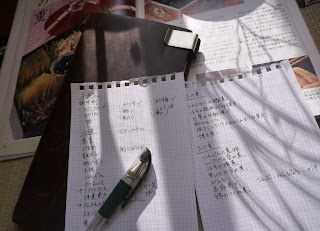
The rice harvest time has come. A grain of rice planted in Spring had sunk its roots deep in the ground, grown over twenty shoots throughout the Summer, with each shoot now bearing several hundred grains. By late Autumn, one rice grain had multiplied six to seven hundred fold, and was drooping under the weight of plump rice grains. I carefully cut the shoots, tie them up in a bundle and hang them over the bamboo poles. I do not neglect a single grain in the field.
When harvesting rice, I picture in my mind the scene of three peasant women in Millet’s famous painting
‘The Gleaner’ (1857) . They stoop to glean the last scraps of wheat in the field, and in contrast, there is a large stack of harvested wheat in the background for their landlords. In some areas of France at that time, it was apparently the usual conduct of landlords to leave some grain unharvested. Gleaning was considered the right of peasants who could not sustain their lives purely by everyday labour.

The other day when I was drinking with my friends at a local bar, one of them raised a question, namely, whether genetically modified crops could save the environment. His example was desertification in China, where rapid economic growth drives Chinese people to eat more meat, and in order to satisfy market demand, farmers are shifting to raise livestock such as cows, sheep and goats (no!) rather than growing vegetables. As a result, there is not enough grass or feed for animals and the trend further hastens desertification. I could have argued against his hypothetical question, based on a documentary film I saw recently, and from which I learned about some repercussions of GM products (for more information about the film, please visit the site:
http://www.thefutureoffood.com/)
The issue that struck me, however, was the fast growing demand for meat, which can be considered a symbol of wealth and success in that society. The vision of splendid banquet scenes, a wealthy Chinese student I met in Australia who never had eaten green vegetables in his life, the endless rotation of a demand and supply cycle on a massive economic scale – all the images made me dizzy.
For farmers, everything begins with seed. Generation by generation, farmers continue selecting the best seeds suited to the soil and climate in each area, and preserve and develop chosen species. However, commonly distributed F1 hybrid seeds are unstable for reproduction, and modified plant gene sequences are now usually patented, so giant corporations gain control of the seed market, and individual farmers risk losing independence. It is easy to criticise corporations and the way that farmers automatically shift their methods and produce in a knee-jerk fashion, but what alarms me is the way parents and consumers unthinkingly seek comfort and pleasure. Most children naturally enjoy meat instead of vegetables (in fact Awako the goat would completely ignore weeds and guzzle sweet cabbage leaves if given the chance. I am tempted...), but I do not believe that to be a good course for their future development. People’s individual outlooks are not simply formed by the corporate world view and pleasure principle. We should consider the way that, as humans, we take responsibility for future generations.
To return to my friend’s question: rather than reacting to consequences (like desertification) with an instant fix solution (like GM), we need examine causes, otherwise a cycle is locked in place.
After the harvest, I separate 2-3% of grain or seed from the portion to be consumed, until the next planting season comes. The French landlords’ custom of leaving 2-3% of crops in fields generated and sustained peasants’ lives. If every one of us who is not at a risk of starvation spared 2-3% of our time or effort on something or somebody else, it could make a great change in the world. I am not a professional scientist or tradesman who can make a direct impact on current trends. However, as a person striving to work in an educational field at the local level, I would like to gather as much information as possible to pass on to the next generation. Therefore, dear and faithful blog readers, if you can suggest any articles, documentaries, websites and so on that might be of future benefit, your small yet invaluable portion of life can be used to join generation to generation.
A seed bearer 種を運ぶヤギ
Cabbage please 「キャベツちょうだい。」
次世代へ
お米の収穫期がやって来ました。春に撒いた一粒のタネ籾が、地中深くまでしっかりと根を張りめぐらし、夏中を通して20株ほどに株を増やし、やがてひと株ごとに数百もの米粒を実らせます。秋の終わりの時分には、一粒のお米が600-700粒に倍増するため、稲たちはたわわに実る穂首を重そうに垂らして、田んぼの中に佇んでいます。ひと株ごとを丁寧に刈り取り、束にまとめ、竹で組んだ稲架に順番に干していきます。畑に一粒のお米も残さないように気をつけながら。
稲刈りをする時に、私の脳裏に思い浮かぶ一枚の絵があります。3人の貧しい農婦の姿を描いた、ミレーの有名な「
落ち穂拾い(1857)」です。少し腰をかがめて、刈り入れ後の畑の中に残る麦の落ち穂を拾い集める農婦、そしてその背景には、地主のための穀物がうず高く積み上げられている様子が対照的に描かれています。当時この地域のフランスの農村では、地主が畑の中に落ち穂を残して収穫をするということが慣習化していたそうです。日々の労働では生活のままならない小作農が、落ち穂を拾って生活の足しにできるようにという配慮からです。
先日、友人たちと近くの居酒屋で飲んでいる時に、仲間の一人が遺伝子組み換え作物が、地球環境を救うとは考えられないかという質問を投げかけました。彼の例は、中国の土壌の急激な砂漠化を防ぐのに有益とは考えられないかというものでした。経済が豊かになった中国では、人々が以前よりもたくさんの肉を消費し、その需要にこたえるために、多くの農民が野菜などの作物栽培農家から、畜産農家へと移行しているということです。牛、羊、ヤギ(!!)などの数が急増、牧草や飼料を食べつくし、その結果として砂漠化が加速しているそうです。彼の仮定的に提示した質問に対して、私なりの意見を言うべきでしたが、うまく話すことができませんでした。最近見たドキュメンタリー映画で、遺伝子組み換えの及ぼす影響を学んだばかりだったにもかかわらず。(映画に関する情報は、こちらのリンクからどうぞ。
http://www.thefutureoffood.com/)
質問の問題点として私を捉えたのは、肉を食べるということがステータスシンボルとなりうる社会の中で、金銭的に余裕さえあれば、人々はやみくもに肉食に走るという傾向についてでした。大皿に盛られたご馳走が所狭しと並べられた饗宴、オーストラリア時代に会った、生まれてから一度も野菜らしきものを口にしたことが無かった中国人留学生、スケールの大きな経済の中で繰り広げられる、需要と供給の終わりなき循環…考えただけで眩暈を感じました。
農家にとって種は全ての始まりです。農家は幾世代にも渡り、その地域の土壌や気候に合った良種を選別し、保管・改善を試み続けてきました。現在市場で出回っているF1交配種は、次世代の生育が不安定であること、遺伝子組み換え種の多くは1世代のみの生命となりがちであること、そして種を扱う大企業が市場を独占しやすい形態を生み、個々の農家が独立して存在しにくくなるという結果をもたらしています。時流に乗り、大企業や、市場のニーズに合わせて生産方式を変えていく農家を批判することは容易です。しかしここで、私が一番危機感を感じた問題は、快適さ、楽しさを無作為に追求する、親たちを含む消費者の心理でした。ほとんどの子供は、肉と野菜とどちらかと言われれば、自然と肉を食べる嗜好を発達させることになるに違いありません。(ヤギの粟子も、庭に生える雑草か畑の甘いキャベツかという選択肢が与えられれば、まよわずキャベツに飛びつくと思います。ちょっと誘惑されますが。)しかし、長い目で考えると、彼らの成長にとって良いことだとは思えません。人々の趣向は、企業戦略や快楽主義思考によってのみ成り立っているわけではないでしょう。生物界に生きる人間として、次世代への責任を持つということを、今一度考え直すべきではないでしょうか。
したがって、上記質問に対する私の意見は、結果(=砂漠化)にてっとり早く(=GM)対応するよりも、そもそもの原因に着目し、改善していかない限りは、同様の循環を断ち切れないのではないか。というものです。
収穫後、自分の食用以外に2-3%ぐらいの種を、次の種蒔き時期に備えて採取します。フランスの地主が畑に刈り残した2-3%の落ち穂は、貧農家庭の生活を支えます。もしも、目前の飢餓の危機感の無い恵まれた私たちが、自身の生活の2-3%の時間もしくは労力を、自分の生活以外の別の物や人に還元したら、社会に何らかの前向きな変化が生まれるのではないでしょうか。私は、専門的な科学者や商社の一線のビジネスマンのように、直接的に現行の流れに関わっていける人間ではありません。私なりに、一地方における教育的貢献を志す身として、次世代に繋げていけるような情報を、少しでも多く収集したいと思っています。ですので、私のブログを読んでくださっている温かい読者の皆様、何か良い記事や、ドキュメンタリー、ウェブサイトなど、将来的に有益だと考えられるような情報がありましたら、是非お知らせ願えませんか?あなたの生活の2-3%が、人類を次世代へと繋げる、かけがえのないものとなることを願って。

































